Origins and Recollections II
by Walter Roberts
The author continues his research into the origins and early history of the United States’ international broadcaster, the Voice of America, and makes some important discoveries.–Ed.
This essay is dedicated to my dear friend Barry Zorthian who passed away on December 30, 2010. Barry started his government career in the Voice of America in the1940s and culminated it as the most respected American spokesman during the Vietnam war in the 60s. He was a superb diplomat.
Several years ago, I became interested in the origins of the Voice of America. I had worked there in 1942 but wanted to supplement my recollections with written facts. The quest for the truth turned out to be far more complex than I ever could have imagined – a Sherlock Holmes exercise in sifting through World War II archives and memoranda. It all began when I called the Voice of America and asked whether they had the scripts or the recordings of the first broadcasts.
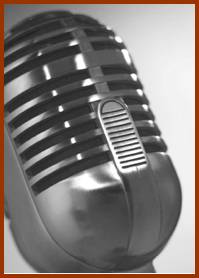 I mentioned this in an article that appeared in these pages in October 2009.* Since then, I have found the CD that VOA had sent me in connection with my inquiry. It is entitled “Voice of America, VOA’s First Broadcast, VOA Wartime Samples, Admiral Doenitz announcing Germany’s Surrender.” The CD contains eight broadcasts in English, German, French and Italian as well as the Doenitz broadcast. Number 6 says: “VOA’s First Broadcast (German – Feb. 1942).” I had listened to this broadcast when I first received the CD and I knew then (and said so in my article) that it was not the first VOA German broadcast. I remembered that the inaugural broadcast began with the Battle Hymn of the Republic and had four speakers, yet broadcast no.6 began with the National Anthem and had only one announcer. (It was a voiced script of February 24 referring to a Fireside Chat of President Roosevelt “yesterday” which indeed took place on February 23). I called VOA, thanked them for sending me the CD but told them that the German broadcast on the CD was not the first broadcast. I was informed that the CD had been prepared on the occasion of the 20th VOA anniversary in 1962 when President John Kennedy visited the Voice of America. Upon asking whether VOA could lead me to the original scripts, they suggested looking in the National Archives.
I mentioned this in an article that appeared in these pages in October 2009.* Since then, I have found the CD that VOA had sent me in connection with my inquiry. It is entitled “Voice of America, VOA’s First Broadcast, VOA Wartime Samples, Admiral Doenitz announcing Germany’s Surrender.” The CD contains eight broadcasts in English, German, French and Italian as well as the Doenitz broadcast. Number 6 says: “VOA’s First Broadcast (German – Feb. 1942).” I had listened to this broadcast when I first received the CD and I knew then (and said so in my article) that it was not the first VOA German broadcast. I remembered that the inaugural broadcast began with the Battle Hymn of the Republic and had four speakers, yet broadcast no.6 began with the National Anthem and had only one announcer. (It was a voiced script of February 24 referring to a Fireside Chat of President Roosevelt “yesterday” which indeed took place on February 23). I called VOA, thanked them for sending me the CD but told them that the German broadcast on the CD was not the first broadcast. I was informed that the CD had been prepared on the occasion of the 20th VOA anniversary in 1962 when President John Kennedy visited the Voice of America. Upon asking whether VOA could lead me to the original scripts, they suggested looking in the National Archives.
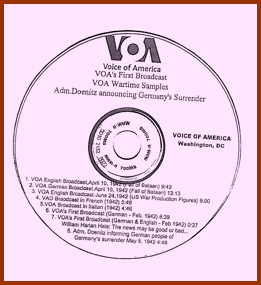 Since the publication of my article there have been two developments. Chris Kern, a retired Voice of America writer, undertook to find these early VOA scripts in the National Archives. With ingenuity and persistence, he succeeded and we now have the German scripts of February 1942 (see his essay A Belated Correction). At the same time, Mike Gray, Librarian of the Voice of America, searched the Library of Congress for the recordings of these early VOA programs. With his knowledge of the Library of Congress system and his inventive talent, he found the recordings of the early German VOA programs. Simultaneously, Kern discovered memoranda written in February 1942 that have shed additional light on the broadcast developments of that time.
Since the publication of my article there have been two developments. Chris Kern, a retired Voice of America writer, undertook to find these early VOA scripts in the National Archives. With ingenuity and persistence, he succeeded and we now have the German scripts of February 1942 (see his essay A Belated Correction). At the same time, Mike Gray, Librarian of the Voice of America, searched the Library of Congress for the recordings of these early VOA programs. With his knowledge of the Library of Congress system and his inventive talent, he found the recordings of the early German VOA programs. Simultaneously, Kern discovered memoranda written in February 1942 that have shed additional light on the broadcast developments of that time.
I am glad to be able to say that the conclusions in my previous article were correct: US Government broadcasts to Europe started on February 1, 1942 and not, as previously assumed, on February 24; and I am now in a position to add data that support my conclusions. Hence this article that I hope will present accurately the historical record of the beginnings of the Voice of America.
I listened to the recording of the inaugural German broadcast of February 1 at the Library of Congress and also read the script of the third German broadcast of February 3. The script is headed “Stimmen aus Amerika. III 3. Februar 1942” – “Voices from America III February 3, 1942.” (Kern did not find the scripts of February 1 and 2). The Roman numeral III indicates that this was the third broadcast. I compared the February 3 script with the recording of that broadcast. It matched word for word.
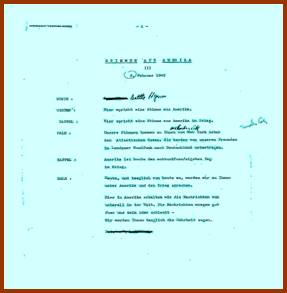
In my 2009 article, I attempted to describe the broadcasting situation that existed after the Japanese attack on Pearl Harbor, with the United States lacking the wherewithal to undertake overseas radio broadcasts because it did not own short wave transmitters. Such transmitters existed, of course, in the United States. But private companies – NBC, Westinghouse, General Electric and others, owned them all. These companies broadcast in foreign languages long before the outbreak of World War II.
Indeed, in May 1938, the three mentioned companies “prompted by the desire to take part in properly representing the United States in international broadcasting developed a generally cooperative operation of their facilities.” (Raymond Guy in RCA Review, July 1938). The cited article not only mentioned the location, frequency and power (5 to 30kw) of the (eight) transmitters but also reprinted a daily broadcasting schedule that included broadcasts in German, French and Italian (two hours each). A General Electric station in San Francisco broadcast to East Asia, at that time only in English.
This changed on August 16, 1940 when President Roosevelt, as a consequence of increased Nazi political and economic interference in Latin America, created the Office for Coordination of Commercial and Cultural Relations Between the American Republics (later called Coordinator of Inter-American Affairs, i.e. CIAA), headed by Nelson Rockefeller. A radio section was set up at 444 Madison Avenue in New York. That section established contact with the private broadcasters that transmitted programs in Spanish, Portuguese and English intended for Latin America. (The CIAA’s radio role is described comprehensively in Robert William Pirsein’s Ph.D. dissertation The Voice of America). The main task of the CIAA’s radio section was that of facilitator – to help the private broadcasters put effective programs on the air. There were no CIAA broadcasts as such and even when the CIAA radio section prepared material, the private broadcasters transmitted it.
The US Government became further involved in international broadcasting on July 11, 1941 when President Roosevelt created the Coordinator of Information (COI) with Col. William J. Donovan in charge. Nazi military victories in Western Europe, North Africa and most recently in the Soviet Union, led Roosevelt to his decision to create the COI. Three days later, the President directed the COI to assume responsibility for international broadcasting. Robert Sherwood, the President’s speechwriter, was appointed Donovan’s deputy and put in charge of the Foreign Information Service (FIS). Sherwood went to New York, leased space at 270 Madison Avenue, and hired, among others, Joseph Barnes, a former Berlin correspondent of The New York Herald Tribune to direct the New York office. The task of that office was to make sure that the private broadcasters put broadcasts on the air that would facilitate the achievement of U. S. informational objectives abroad. The COI/FIS operation was worldwide – except Latin America that was and remained the CIAA’s responsibility.
America was still at peace. Pearl Harbor was five months away. Barnes set up language desks that supplied the private broadcasters with news and commentaries in foreign languages consistent with American foreign policy goals. In the autumn of 1941, the private broadcasters were not only broadcasting in English, German, French, Italian, Spanish and Portuguese but also in Czechoslovak, Swedish, Norwegian, Danish, Finnish, Polish, Greek, Turkish, Dutch, Cantonese and Mandarin.
While CIAA-private broadcasters relations developed fairly smoothly, COI encountered resistance from those stations regarding the content of the broadcasts. The US Government itself did not broadcast prior to Pearl Harbor.
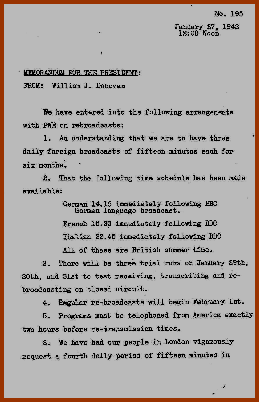 |
 |
The situation changed after Japan attacked the U.S. on December 7, 1941. A decision was made that the US Government itself would initiate radio programs, lease privately owned short wave transmitters for this purpose, and obtain relay facilities from the British Broadcasting Corporation (BBC) in order to increase the programs’ audibility in Europe.
Shortly before Pearl Harbor, the COI had decided to open a “Pacific Bureau” in San Francisco. One of its first tasks was to find Japanese writers and speakers, a difficult undertaking in the circumstances then prevailing with regard to citizens of Japanese ancestry (see William Winter, Voices from America). At the same time, Cantonese and Mandarin writers and speakers were recruited from the private stations in New York for transfer to the COI office in San Francisco. Eight days after Pearl Harbor, two English programs prepared by COI’s San Francisco office were broadcast to the Philippines via KGEI (a General Electric owned station) and by December 28, eight English programs, as well as Tagalog, Cantonese, Mandarin and Amoy broadcasts, were transmitted daily to the Philippines from where they were relayed on medium and short wave frequencies. In the middle of March 1942, the COI Pacific Office initiated Japanese broadcasts.
After Pearl Harbor, the private short wave stations continued their foreign language programs as before. The CIAA had few if any problems with that procedure. The COI, however, decided to lease as many private short wave transmitters as possible to accommodate the increasing number of its language sections that prepared programs, several even in the same language as broadcast by the private stations. This arrangement proved difficult to manage. Consequently, using wartime powers, the US Government took over all private short wave facilities on November 1, 1942. The Office of War Information (OWI) (created on June 13, 1942 and as VOA’s new parent agency) assumed control of two thirds of these transmitters and CIAA of one third. In addition, the U. S. Government began building more powerful short wave transmitters.
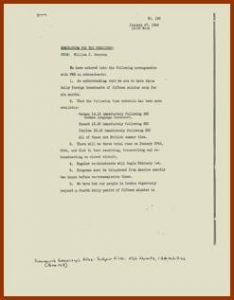 |
 |
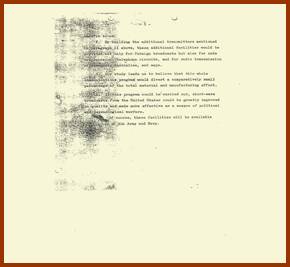 |
The main priority of the COI/FIS in early 1942 was to construct an effective radio program, first in German. John Houseman, the new broadcasting director who had a long theater and film career in producing and directing, decided to design such a program. He writes in his book Front and Center: “My first decision was to get away from the single-voice news reporting of the private stations and BBC. The Voice of America would, in our broadcasts, be represented by several voices of different quality and pitch carefully orchestrated to achieve a maximum of variety and energy.” Houseman chose William Harlan (Bill) Hale, Peter Kappel, Stefan Schnabel and Roland Winter as announcers of the first German broadcast. The COI German language section, created shortly after the COI was established in July 1941, provided the news and commentaries for the broadcasts, including the often-cited phrase: “Die Nachrichten moegen gut fuer uns sein oder schlecht —Wir werden Ihnen taeglich die Wahrheit sagen.” (“The news may be good for us or bad. — We shall tell you the truth every day.”).
The COI representatives in London arranged with the BBC a daily relay system whereby not only German but also French and Italian programs would be sent by radio/telephone to London from where the BBC would transmit them (two hours later) via medium wave to Europe. It was on the basis of a BBC memorandum sent to me from the BBC Archives that I stated in my previous article that the first COI broadcast to Europe was in the German language and took place on February 1, 1942. Thanks to Kern’s research at the National Archives, I can now add a memorandum by COI Director Donovan to President Roosevelt, dated February 4, 1942 confirming the inauguration of the first COI broadcasts.
Were they Voice of America broadcasts? The aforementioned BBC memorandum contains the following sentence: “The title of the broadcasts will be ‘America Calling Europe’.” And indeed broadcasts in English as well as in French and Italian that were included in the previously mentioned VOA CD introduced themselves as follows: “This is New York. The United States of America Calling the People of Europe (English)… the People of France (French)… the People of Italy (Italian).”
Yet we know from John Houseman’s book that Robert Sherwood had decided that the COI broadcasts, “…would be known as ‘The Voice of America’.” And we have evidence from the early German scripts that the term Voice of America was discussed when the German scripts were written at the end of January. Clearly, the translation into German of “Voice of America” presented a problem for the German writers. Some of them opposed the literal translation of Voice of America: Die Stimme Amerikas. It appeared to make them feel uncomfortable. Bill Hale said years later that Die Stimmen Amerikas (Voices of America) was a better term. Indeed, the heading of these early German broadcasts was “Die Stimmen Amerikas”. Yet the English translations of the broadcasts that are available (February 11 and 24) are headed “The Voice of America.” In the text of these first German broadcasts, the term “Hier spricht eine Stimme aus Amerika” (Here speaks a voice from America) was translated into English in one instance as “The Voice of America Speaks” and in the second “This is the Voice of America.” In other words, the term “Voice of America” was known as early as late January 1942.
On February 1, the first German, French and Italian broadcasts were transmitted by the COI to London via radiotelephone for retransmission by medium wave to Europe. We know that John Houseman directed the German program. But what about the French and Italian programs transmitted on the same day? It turns out that the COI French and Italian language sections were not yet ready to produce these programs but had to “borrow” them from NBC. (See my reference above that NBC in conjunction with other private radio stations had for several years been broadcasting in French and Italian).
In an undated memorandum (but probably written in June 1942) intended for incoming OWI director Elmer Davis, Houseman wrote that the German broadcast, “was the only broadcast made and transmitted directly by the COI in New York.” Two other daily broadcasts (in French and Italian) were handled for the COI by the National Broadcasting Company. Cabled comment from London soon justified our belief that for clarity and propaganda value, the new Voice of America technique was distinctly superior to the routine broadcast with a single announcer. We also discovered that it was difficult to give to a broadcast, made by a private company outside the immediate control of the COI, the degree and intensity of angling which seemed desirable in the first American medium-wave broadcast to be heard by the population of Europe. For these reasons, on February 26th the COI began the daily transmission of three fifteen minute programs for re-broadcasting by BBC: one German, one French and one Italian. On March 8, an English program was added.
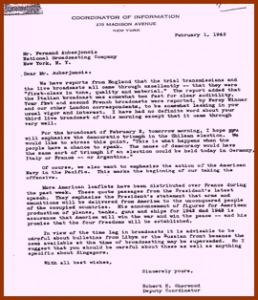 Thus, from February 1 to February 25, the French and Italian programs sent to London were prepared by NBC and not by COI. That explains an exchange of letters between Robert Sherwood and Fernand Auberjonois, the French editor at NBC (who later transferred to COI). On February 1, 1942, Sherwood wrote Auberjonois about the London reaction to the dry-run French broadcasts of January 29, 30 and 31. The letter is addressed to the National Broadcasting Company and formally “Dear Mr. Auberjonois.”
Thus, from February 1 to February 25, the French and Italian programs sent to London were prepared by NBC and not by COI. That explains an exchange of letters between Robert Sherwood and Fernand Auberjonois, the French editor at NBC (who later transferred to COI). On February 1, 1942, Sherwood wrote Auberjonois about the London reaction to the dry-run French broadcasts of January 29, 30 and 31. The letter is addressed to the National Broadcasting Company and formally “Dear Mr. Auberjonois.”
In his memorandum for the new OWI director, Houseman wrote that the first German program was called “The Voice of America.” Throughout his memorandum, when he also mentions French, Italian and English programs, he refers to them as “Voice of America” programs. As the months went by, and more languages were added almost daily by the COI, the introductory words “This is the Voice of America” and translations thereof were increasingly used by the different language services. While these language broadcasts were transmitted by short wave transmitters, one German, French, Italian and English broadcast a day was sent additionally by radio/telephone to London from where the BBC relayed them to Europe via medium wave.
Even though COI programs were broadcast from the San Francisco office a few weeks before the German program was launched from the New York office, they did not carry the banner “Voice of America.” From the literature available to me, it was not until 1944 that the San Francisco office adopted “The Voice of America” identification.
Therefore, the Voice of America is justified in tracing its beginnings to February 1, 1942 when the first German broadcast went on the air, entitled “Stimmen aus Amerika” but “Voice of America” in the English translation.
The original musical introduction to the German program was the “Battle Hymn of the Republic.” However, we soon learned that a German army song called “Laura, Laura” had the same tune. So the Battle Hymn was replaced for a short time by our National Anthem to be succeeded by “Yankee Doodle,” for many years the signature tune of the Voice of America.
The COI office on Madison Avenue in New York had two studios. By spring 1942, English, German, French and Italian broadcasts were produced around the clock in one studio. From the other, programs in the Iberian, Slavic, Scandinavian and other languages were broadcast.
I have in my files a photograph of myself sitting in front of a microphone with the words: “Die Stimme der Vereinigten Staaten Amerikas” During a short period in 1944, we were instructed to change the moniker “Voice of America” to “Voice of the United States of America”. We were told that the Coordinator of Inter-American Affairs requested this. The reason given was that the term America included Latin America. After a relative short time, we reverted to “Voice of America.” (I understand that in Spanish broadcasts to Latin America today producers are still sensitive to the CIAA concerns: openings are always “The Voice of the United States — ‘Estados Unidos’ — of America”).
During World War II, the term “Voice of America” was not well known outside our office. If someone had asked me then where I worked, I would have answered, “in the Office of War Information,” rather than in the Voice of America. After September 1, 1945, when President Truman transferred the foreign information activities of the OWI (including VOA) to the Department of State, I probably would have answered differently. Working in New York, I would have felt it misleading to tell people that I was employed by the State Department, and would have said that I worked in the Voice of America.
It is therefore not surprising that William Benton whom President Truman appointed in August 1945 as Assistant Secretary of State for Public Affairs was astonished by the scope and role of the VOA programs that had become his responsibility.
I asked my friend Alan Heil, the author of the excellently written and all encompassing book The Voice of America, who joined the Voice of America in 1962 (and rose to the deputy directorship) whether he would have said that he worked in the US Information Agency (USIA), then VOA’s parent agency, or for the Voice of America. He answered, “Voice of America.” By that time, particularly in view of the important VOA role during the Cold War, the Voice of America was widely known and respected. I take this occasion to thank Alan for his assistance in my research. His encyclopedic knowledge of the Voice of America and his readiness to share it have been invaluable.
The Voice of America has celebrated its anniversary on two dates: first, on February 25 and thereafter on February 24.
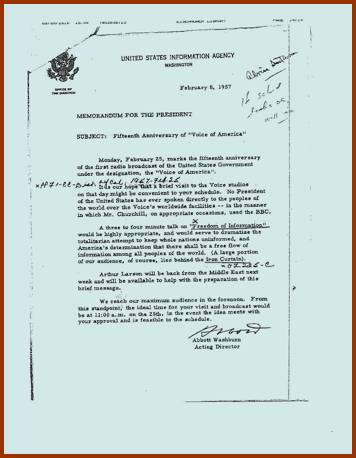
On February 25, 1957, President Dwight Eisenhower visited the Voice of America, the first President to do so. He used that occasion to give a major foreign policy speech entitled “World Broadcast in Observance of Fifteenth Anniversary of Voice of America, February 25, 1957.”
Mike Gray of VOA was able to obtain a memorandum from the Eisenhower Library in which Abbott Washburn, then USIA Acting Director, wrote President Eisenhower on February 8, 1957: “Monday, February 25, marks the fifteenth anniversary of the first radio broadcast of the United States Government under the designation, the ‘Voice of America’.” Washburn did not say that February 25 was the anniversary of the first government broadcast; what the memorandum did say is that it was the anniversary of the first broadcast designated as a VOA broadcast.
Although I have found no corroborative evidence, I must assume that Washburn had proof for his statement. We know that Robert Sherwood wanted the COI broadcasts to be known as Voice of America broadcasts. Was a memorandum to that effect perhaps issued on February 25, 1942? Or did the fact that the first COI produced French and Italian broadcasts joined those of German on the 26th of February play a role? A U. S. Government-produced multi-language network, possibly designated as VOA, was to be initiated a day after the 25th.
In 1962, VOA shifted its anniversary date to February 24. The (unofficial) History of Voice of America Language Services says that on “February 24, FIS transmitted its first broadcast to Europe…that broadcast was in German…the 24th was declared VOA’s official birthday.” Was this decision made because a February 24 broadcast script in German was found and judged to be the first broadcast? In this connection, it is noteworthy that the National Archives informed me last year that they had only one VOA script on file – that was before Kern discovered others – and that was an English translation of a German script dated February 24.
All recent VOA anniversaries have been celebrated on February 24. I was invited to participate in the 50th (February 24, 1992) as one of four “survivors” of the beginnings of VOA. (Regrettably, my three colleagues have since passed away).
After my article was published in American Diplomacy last year, the VOA website dropped February 24 as the anniversary date and now simply says that the Voice of America “went on the air in February 1942”. However. I understand that as a result of this research, VOA will change the date of its first broadcast to February 1, 1942.
In 2012, the Voice of America will celebrate its 70th anniversary. I hope it will be on February 1. The communications revolution has resulted in many changes. Gone are the days when VOA had to rely on leased and weak short wave transmitters to broadcast its message around the world. Today, it disseminates the news as well as information about America, its society and its policy, not only through radio, but also via TV and Internet in 44 languages to an estimated weekly worldwide audience of 123 million people.
The Voice of America is and will continue to be a vital function of 21st century American diplomacy.
*See: http://www.unc.edu/depts/diplomat/item/2009/1012/fsl/roberts_voice.html
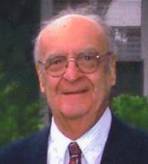
Dr. Walter R. Roberts started his government career with the Voice of America. He retired from the government after serving as Associate Director of the U.S. Information Agency. President George H. W. Bush appointed and President Bill Clinton reappointed him as member of the U.S. Advisory Commission on Public Diplomacy. He is the author of Tito, Mihailovic and the Allies, 1941-1945 and numerous articles on foreign policy.
